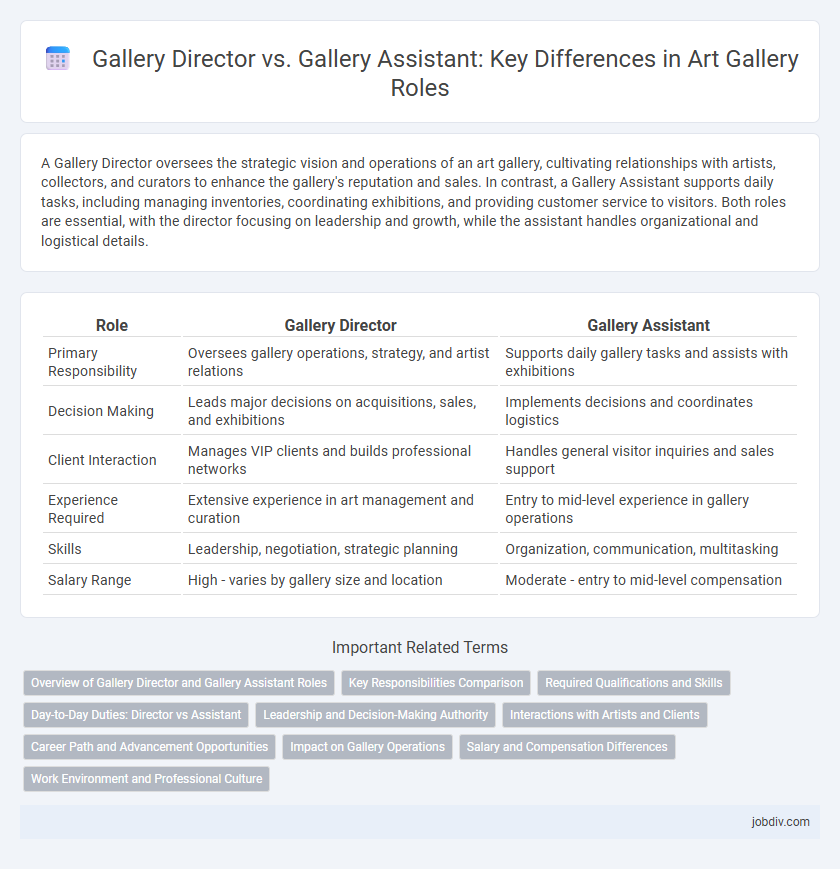A Gallery Director oversees the strategic vision and operations of an art gallery, cultivating relationships with artists, collectors, and curators to enhance the gallery's reputation and sales. In contrast, a Gallery Assistant supports daily tasks, including managing inventories, coordinating exhibitions, and providing customer service to visitors. Both roles are essential, with the director focusing on leadership and growth, while the assistant handles organizational and logistical details.
Table of Comparison
| Role | Gallery Director | Gallery Assistant |
|---|---|---|
| Primary Responsibility | Oversees gallery operations, strategy, and artist relations | Supports daily gallery tasks and assists with exhibitions |
| Decision Making | Leads major decisions on acquisitions, sales, and exhibitions | Implements decisions and coordinates logistics |
| Client Interaction | Manages VIP clients and builds professional networks | Handles general visitor inquiries and sales support |
| Experience Required | Extensive experience in art management and curation | Entry to mid-level experience in gallery operations |
| Skills | Leadership, negotiation, strategic planning | Organization, communication, multitasking |
| Salary Range | High - varies by gallery size and location | Moderate - entry to mid-level compensation |
Overview of Gallery Director and Gallery Assistant Roles
Gallery Directors oversee the strategic vision, artist relations, and financial management of art galleries, ensuring exhibitions align with brand identity and market trends. Gallery Assistants support daily operational tasks, including coordinating events, managing inventory, and providing customer service to enhance visitor experience. Both roles collaborate to maintain the gallery's reputation, but directors focus on leadership and business strategy, while assistants handle administrative and logistical duties.
Key Responsibilities Comparison
Gallery Directors oversee overall operations, including strategic planning, artist relations, and exhibition curation, ensuring the gallery's financial health and market positioning. Gallery Assistants handle daily administrative tasks such as client communication, inventory management, and event coordination to support smooth gallery functions. Directors focus on leadership and decision-making, while Assistants prioritize operational support and logistical execution.
Required Qualifications and Skills
Gallery Directors require advanced degrees in art history or arts management and demonstrate strong leadership, strategic planning, and fundraising skills essential for managing gallery operations. Gallery Assistants typically hold bachelor's degrees or relevant certifications, emphasizing organizational abilities, customer service, and familiarity with exhibition logistics to support daily functions. Both roles necessitate comprehensive knowledge of contemporary art trends and excellent communication skills to engage effectively with artists, collectors, and the public.
Day-to-Day Duties: Director vs Assistant
The Gallery Director oversees strategic planning, curates major exhibitions, and manages high-level relationships with artists, collectors, and stakeholders, ensuring the gallery's vision aligns with market trends. The Gallery Assistant handles daily operational tasks such as coordinating visitor services, managing inventory, organizing artwork installations, and supporting sales transactions. While the Director focuses on long-term growth and external communications, the Assistant ensures smooth internal workflows and immediate visitor engagement.
Leadership and Decision-Making Authority
A Gallery Director holds primary leadership responsibilities, overseeing the strategic vision and operational decisions of the gallery, including curatorial direction, artist representation, and financial management. In contrast, a Gallery Assistant supports daily administrative tasks and client relations with limited decision-making authority, often executing directives rather than formulating policy. The Director's role demands high-level decision-making capabilities impacting the gallery's reputation and market position.
Interactions with Artists and Clients
Gallery Directors manage high-level interactions with artists and clients, overseeing exhibitions, sales strategies, and curatorial decisions to enhance the gallery's reputation and commercial success. Gallery Assistants handle day-to-day communications, assisting artists with logistical needs, coordinating appointments, and supporting client inquiries to ensure smooth operations. While Directors focus on strategic relationships and long-term partnerships, Assistants maintain personalized, frequent contact that facilitates immediate client and artist engagement.
Career Path and Advancement Opportunities
Gallery Directors typically oversee overall operations, curating exhibitions, managing budgets, and developing strategic partnerships, which require extensive experience and leadership skills. Gallery Assistants often start in entry-level roles, supporting daily gallery functions, assisting with installations, and maintaining artist relations, providing foundational exposure to gallery management. Career advancement for Assistants can lead to curator positions or Gallery Director roles through gaining expertise in art curation, business management, and networking within the art industry.
Impact on Gallery Operations
The Gallery Director oversees strategic decisions, artist relations, and high-level sales, directly influencing the gallery's reputation and financial success. The Gallery Assistant manages daily operations, client communication, and exhibition setup, ensuring smooth workflow and visitor satisfaction. Together, their roles create a cohesive environment that drives both operational efficiency and artistic excellence.
Salary and Compensation Differences
Gallery Directors typically earn a higher salary than Gallery Assistants, with average annual compensation ranging from $60,000 to $100,000 compared to $30,000 to $50,000 for assistants. Directors receive additional benefits such as performance bonuses, profit sharing, and comprehensive health insurance that are less common for assistants. The salary gap reflects the Director's greater responsibility for curating exhibitions, managing staff, and driving gallery sales and marketing efforts.
Work Environment and Professional Culture
Gallery Directors typically work in fast-paced, high-pressure environments where leadership and strategic decision-making shape the gallery's vision and community presence. Gallery Assistants often experience a collaborative workspace, focusing on hands-on tasks like exhibition setup, artist liaison, and visitor engagement. Professional culture for Directors emphasizes networking, curatorial expertise, and business management, while Assistants benefit from mentorship, skill development, and operational support within the art community.
Gallery Director vs Gallery Assistant Infographic

 jobdiv.com
jobdiv.com